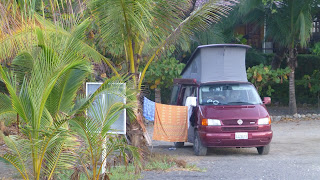Friday February 26.
Left Boquete for David where we looked for a transmission shop with the usual
difficulties getting good information and directions and navigating. The Panamanian-American
owner of Transmissions Panama lived in Miami for 30 years where he ran a
transmission shop until competition by Cuban immigrants made it too hard to pay
good wages and benefits and guarantee the work and still make a living. He said
our transmission is fine. Then we drove all over the steaming, congested
downtown looking for the hat shop that Axel told us about. Mike wants to buy a
Panama hat: a hand woven straw hat really made in Panama, not a Chinese
knock-off of the classic style. We didn’t find one to his liking until we went
to another small town the woman in the transmission shop told us about. Mike
liked the one in the locked, glass case: it cost $65—more than twice the price
of the others that he thought were too expensive for inferior quality. The shop
owner sold it to him for $60. Panama uses US dollars. We retreated to the van,
parked in a shady spot, to eat a good lunch of sockeye salmon salad on rustic
French bread bought at the Boquete bakery.
We headed for the
border about 1pm. Miracle of miracles, it took less than 30 minutes to cross!
And it was free! Except for a small tip to the adjudante and the inspector. Peñas Blancas is the same station we
went through on our way south, so we knew where everything was, and there were
no lines. Leaving Panama was straight forward, just the exit paper for
immigration and turn in the customs paperwork for the car at customs. On the
Costa Rica side the aduana had
suspended our previous paperwork so all we had to do was fill in a form to
reinstate it--our auto insurance was still good--and fill in the entry papers
for immigration. And drive through the fumigation “car wash.” We haven’t seen a
stink bug for a week, so we are hopeful all this border crossing has resolved
the infestation.
 |
| Watching the sun go down on Playa Hermosa |
 |
| Camping on the beach |
Saturday February
27. I begged an egg from the cook at the restaurant and made French toast with
the French bread from the bakery in Boquete. Yum!
Puntarenas, an hour
north, was our next destination: a long spit of sand out into the Gulf of
Nicoya. We drove through the one-street town to the point. It is developed with
a waterfront promenade, which of course lured us to walk in the wind and sun
along the
perimeter. We were planning to check out the marina, but discovered
the ferry landing, with two vessels loading up to cross the Gulf to the Nicoya
Peninsula. We made an impulse decision to go, ran back to get the car, bought
tickets, and were the last vehicle on board to Playa Naranja. It was wonderful
being out on the water, in the wind, watching the seagulls and terns play in
the updraft from the boat, and watching the changing terrain. It was a two-hour crossing—probably slower
than usual due to the strong winds. It took the captain three tries and an
extra 45 minutes to land the ferry at the dock, due to the wind. I thought we
might have to go back…
 |
| The point at Puntarenas, Costa Rica |
We looked at the
map and chose a road north to the beaches on the outer coast. The road went up
over the spine of the peninsula and down the other side. When it turned to
gravel driver Mike got discouraged and retreated a few kilometers back to a
town to ask directions for a better route. The Red Cross guy assured us that
this road was the most direct, it was only 15 minutes’ worth of gravel and then
we would get pavement again. So we persevered, and arrived at the most
beautiful,
palm-lined beach ever, with no development other than a few park
benches and tables. The neighbors—a couple from Canada who had been here for
three months—visited with us and told us where to find our beer and ceviche up
the road at Playa Samara. Back in the van—but it wouldn’t start. So we waited
ten minutes, and I took a bathroom break. It still wouldn’t start. So I put on
my swim suit and went out through the surf for a salty swim while landlubber
Mike walked the beach. If the car didn’t start, that was fine by me: it would
be a beautiful place to camp. But the engine had cooled off enough and did
start this time, so we went in to town for our beer and ceviche. We found a
beachfront restaurant run by young Italians. The people watching was good, but
the Oro ceviche was tough and not very piquant.
 |
| The most beautiful beach of all |
After soliciting route
advice from the local police and briefly trying to find and consult a local
mechanic, we returned to the first beach to eat a light supper and camp. We
laid out on a sarong on the warm sand and watched the stars. The sky was very
clear and dark, as the half-moon had not yet risen. I could see all the stars
on Orion’s sword and the Milky Way was in full splendor.

No comments:
Post a Comment